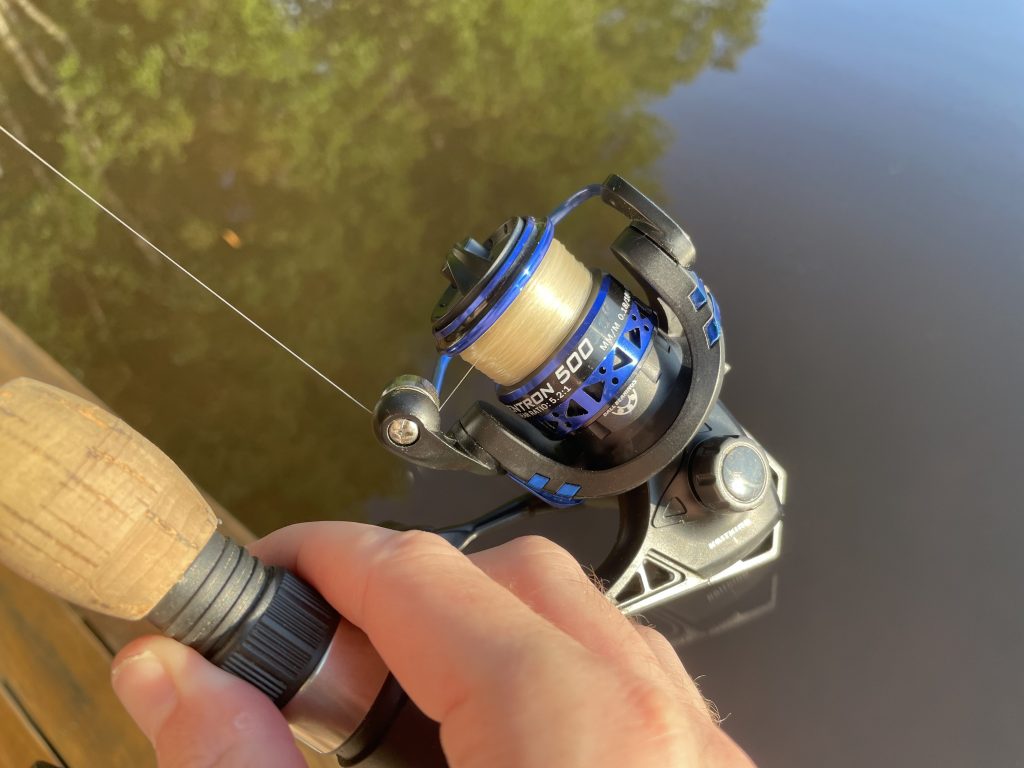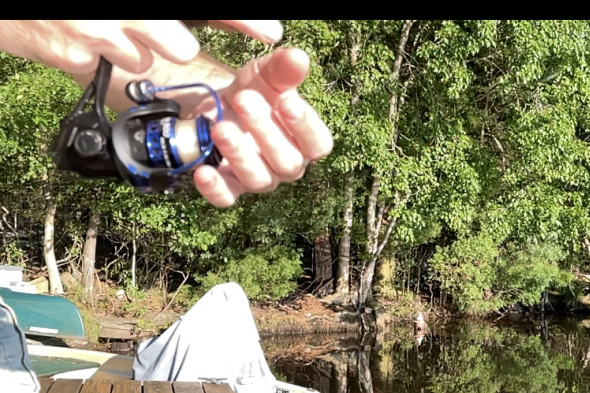
“Fast is fine, but accuracy is everything.” ~Wyatt Earp
See that? It’s a spinning reel. It, unlike most modern baitcasters, does not have a braking system, whereas casters tend to have two: mechanical and centrifugal brakes. Between the two of these, casters can be tuned with great precision, making long, extremely accurate casts possible (with adequate practice, of course!)
Now, don’t get me wrong. Spinners are often preferred by many anglers because it is, simply put, much easier to learn to cast them. It takes weeks if not months of practice with a caster to gain proficiency, and even the most experienced fishermen occasionally suffer the dreaded backlash. Even many who become expert casters struggle to cast lures that weigh south of a quarter ounce.
Spinners, however, are easy to learn to cast. It is a simpler skill to master and the limit on the mininum total weight you can effectively cast accurately is a product of line weight, not lure weight.
Subsequently, and as I observed, spinning reels are preferred by many fishermen.
Nonetheless, they are not without their drawbacks – though in the scope of this blog I will focus on only one: accuracy.
One of the great advantages of casting reels is their immense accuracy. With practice, experienced fishermen can cast both light and heavy lures with a caster, very accurately, dropping the cast precisely where they want while producing hardly a ripple on the surface of the water.
This is very difficult to do with a spinning reel.
But it is not impossible.
You see, the fixed spool of a spinning reel does limit casting accuracy – to a point. You can still be very accurate with a spinning reel, dialing in your accuracy in increments that vary by degrees of only one revolution of the line around the spool.
Have you ever had an experience with a spinner where you put too much power behind the cast or released the lure at an inopportune time, sending it on a trajectory that would send it too high or too far? With my technique, you can make adjustments to lure trajectory mid cast that will substantially improve your accuracy.
This technique, which I call braking a spinning reel, can also be called feathering – or so I have also heard it referenced.
Here’s how to do it.
How to Do It (Braking a Spinning Reel)
Braking a spinning reel is quite easy. In fact, it takes much less skill and practice than learning to thumb a baitcaster, so to me it’s a wonder why more anglers don’t practice this. Or perhaps they do, and I see it only rarely.
Cast as you would normally; the casting motion and action are unchanged here. If you like the trajectory, angle and speed of the lure, do nothing; no braking is necessary.
However, if the lure is too high, moving too fast, or on path to go too far, cup your non-dominant hand (for me, my left) and cover the front of the spool.
Do not close your hand entirely or you will arrest the fight of the lure and it will stop cold.
What you want to do is apply a little bit of friction on the loops of line coming off of the spool. The mild friction from your hand will slow the line and by extension, the lure.
To slow the flight of the lure more aggressively, cup your hand more tightly; adjust the tension of the line moving past your hand by adjusting how tightly or loosely your hand is cupped over the spool.
Again, take care not to get too close to the spool or as I mentioned, the lure will stop cold and you may break the line.
It’s as easy as that – one of the easiest skills I have covered on this site so far.
So, why do you need to know how to do this if you’re going to stick with a spinning reel forever and never master the caster?
Why Is Braking a Spinning Reel an Important Angling Skill?

The most important reason that braking a spinning reel is an essential angling skill is, obviously, accuracy.
If your lure is on trajectory to go too far, braking a spinning reel can easily slow it down so you can more accurately place it.
This is not only important when targeting fish but for the purposes of saving your lures. I assume, if you have ever spent a day fishing, you have made at least one lure an ambassador to the realm of the tree limbs. I myself am not too proud to admit it.
I will even go so far as to admit that I have not only made my tackle box and the trees intimate, but that I have lost lures in the process.
But, by braking a spinning reel, I have learned how to alter the flight of many an errant cast, losing far fewer lures to the trees than I would have otherwise.
So we have accuracy and saving lures from getting lost on snags due to inaccurate casts. There is also the matter of presentation.
The harder a lure hits the water, the more likely it will be to spook wary fish. I have seen fish flee in fright from violent presentations. The thing is, sometimes an aggressive plop actually attracts fish.
You never know till the lure hits the water, though, and it’s best to play it safe if you don’t know how frisky the fish are feeling at that moment in time.
My point being this: braking a spinning reel allows you to make subtler, less aggressive presentations which are unlikely to spook fish.
Finally, knowing how to brake a lure mid-cast can also help prevent unfortunate fouls. I have already written before about how to modify spinners to prevent them from fouling; but braking is also an important skill that can help prevent this.
For instance, plugs like Rapalas often foul when they are cast errantly. Braking the line at the last second before the lure hits the water straightens it and the line out and makes it less likely that the lure will tangle with the loose line as it hits the water.
Happy [accurate] casting, and tight lines.
~The Eclectic Outfitter